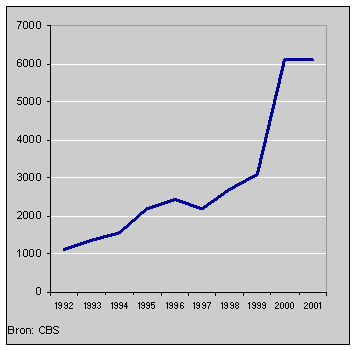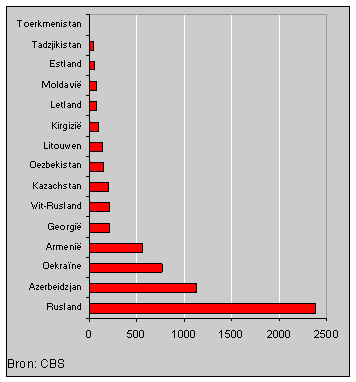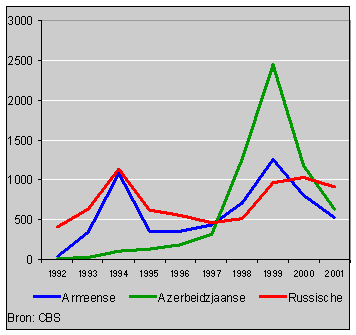Immigration from former Soviet republics on the rise

Immigration from the former Soviet republics has been increasing in recent years. In 2001 over 6 thousand people migrated to the Netherlands from there, whereas a decade ago there were just over a thousand. In total 29 thousand people from the former Soviet Union migrated to the Netherlands within the last decade.
Immigrants from the former Soviet republics

Russians are the biggest group
The largest group of migrants from the former SU comes from Russia. In 2001 their share was about 37%. The situation in Chechnia may have played a role in this.
In the last two years there were also many migrants from Armenia, Azerbaijan and the Ukraine. The number of immigrants coming from the other former Soviet republics is small.
Immigrants from the former Soviet republics, 2001

Increase in asylum requests seems to be over
The number of asylum seekers of Russian nationality had increased to about 1 thousand in 2000. Last year there was a decrease.
In 1999 the number of Azerbaijani asylum seekers was relatively high namely 2.5 thousand, whereas in 2001 their number had dwindled to just over 600.
The same pattern can be observed among the Armenian asylum seekers. These three groups, of Armenian, Azerbaijani and Russian nationality, constituted two thirds of the total number of asylum seekers from the former SU. The figures from the Centraal Register Vreemdelingen of the Ministry of Justice show that about 60% of all immigrants from the former SU came to the Netherlands as asylum seekers in 2001.
Asylum requests by nationality

Netherlands popular among women for family formation
The majority of migrants from the former SU are women (57%). Women come more often for family formation than men. About 950 of the 1 thousand migrants who came to the Netherlands for family formation in 2001 were women. Consequently, the number of married couples consisting of a woman born in the former SU and a Dutch man (2.3 thousand on 1 January 2001) far exceeds the number of married couples consisting of a man born in the former SU and a Dutch woman (almost 200 on 1 January 2001). The same is true for the other Eastern European countries, Poland in particular. It is also often the case for non-European countries that are well-known as the countries where Dutch men find brides, such as Colombia, the Philippines and Thailand.
Maarten Alders and Han Nicolaas